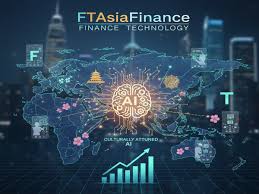FTAsiaFinance Technology: Transforming the Future of Finance

Introduction
The financial world is undergoing a radical transformation. Traditional banking methods are rapidly giving way to innovative, technology-driven solutions that are more efficient, inclusive, and accessible. At the heart of this evolution is FTAsiaFinance Technology, a concept and movement that symbolises the merging of finance and digital innovation across Asia.
From artificial intelligence and blockchain to mobile banking and digital payments, FTAsiaFinance Technology is changing how individuals, businesses, and governments manage, transfer, and grow money. This article explores its rise, its impact on global finance, and why it matters for the future of economic growth and digital inclusion.
What is FTAsiaFinance Technology?
FTAsiaFinance Technology refers to the integration of advanced technologies into the financial sector with a strong focus on Asia. It covers a wide spectrum of innovations, including:
-
Blockchain and decentralised finance (DeFi)
-
Artificial intelligence and machine learning
-
Digital banking and mobile wallets
-
Big data analytics and risk management tools
-
Cybersecurity and fraud prevention systems
While the term is gaining recognition in blogs and discussions, its essence lies in a broader transformation: reshaping finance with technology to make financial services more accessible, faster, and secure.
The Role of Asia in Financial Innovation
Why Asia is Leading the Digital Finance Revolution
Asia has become a hub of financial innovation for several reasons:
-
High adoption of mobile technology – Countries like China, India, and Indonesia have leapfrogged traditional banking by embracing mobile wallets and QR code payments.
-
Growing middle class – A rising demand for accessible financial services is driving fintech adoption.
-
Government support – Regulatory frameworks in Singapore, Hong Kong, and Japan are designed to encourage digital innovation.
-
Unbanked population – Millions of people without access to traditional banks are turning to digital solutions.
China’s Dominance in Digital Payments
China’s Alipay and WeChat Pay demonstrate how FTAsiaFinance Technology can reshape consumer behaviour. With billions of transactions processed daily, digital payments have replaced cash as the norm.
India’s Push for Financial Inclusion
Through the Unified Payments Interface (UPI), India has created one of the world’s fastest-growing digital payment ecosystems. FTAsiaFinance Technology finds fertile ground here by providing affordable solutions for rural and semi-urban communities.
Core Components of FTAsiaFinance Technology
Artificial Intelligence in Finance
AI and machine learning are central to FTAsiaFinance Technology. They enable:
-
Predictive analytics for investment decisions
-
Automated chatbots for customer support
-
Fraud detection and prevention systems
-
Personalised financial planning tools
Blockchain and Decentralised Systems
Blockchain brings transparency and trust to financial transactions. Smart contracts, decentralised lending platforms, and cryptocurrency exchanges are direct results of this innovation.
Big Data and Advanced Analytics
Financial institutions now rely on big data to:
-
Analyse customer behaviour
-
Detect fraudulent activities
-
Optimise lending and credit scoring models
Cybersecurity and Digital Trust
With the rise of digital finance comes the increased threat of cybercrime. FTAsiaFinance Technology prioritises cybersecurity tools such as biometric verification, encryption, and advanced fraud monitoring systems.
The Benefits of FTAsiaFinance Technology
Enhancing Financial Inclusion
One of the most powerful impacts of FTAsiaFinance Technology is financial inclusion. Millions of unbanked people now have access to mobile wallets, digital credit, and micro-financing options.
Speed and Efficiency
Digital transactions powered by FTAsiaFinance Technology are instant, reducing the delays associated with traditional cross-border payments.
Transparency and Security
Blockchain ensures greater transparency and accountability, reducing corruption and increasing trust in financial systems.
Cost Reduction for Institutions and Customers
Automation lowers operational costs for banks and fintech companies, which translates into lower fees for customers.
Challenges Facing FTAsiaFinance Technology
Regulatory Hurdles
Governments worldwide are still grappling with how to regulate cryptocurrencies, digital assets, and decentralised platforms.
Cybersecurity Threats
As digital finance grows, so does the risk of hacking, identity theft, and fraud. Building trust through strong security frameworks is essential.
Digital Divide
Not everyone has equal access to the internet or digital literacy. Bridging this gap is vital to ensure that FTAsiaFinance Technology benefits everyone.
The Future of FTAsiaFinance Technology
Emerging Trends
-
Green fintech – Integrating sustainability into financial services
-
AI-powered personal finance apps – Helping individuals manage their money smarter
-
Decentralised finance (DeFi) – Providing alternatives to traditional banking
-
Central Bank Digital Currencies (CBDCs) – National digital currencies being tested across Asia
The Role of Start-ups
Asian start-ups are at the forefront of driving FTAsiaFinance Technology. From micro-lending platforms to blockchain-based payment solutions, their innovations are reshaping the financial landscape.
The Global Ripple Effect
Although rooted in Asia, FTAsiaFinance Technology has global implications. Its innovations are influencing fintech ecosystems in Africa, Europe, and North America.
Conclusion
FTAsiaFinance Technology is more than just a buzzword—it represents a transformation in how financial services are delivered, accessed, and trusted. By harnessing artificial intelligence, blockchain, and big data, it is making finance more inclusive, efficient, and secure.
As Asia continues to lead this digital revolution, the rest of the world is watching closely. For individuals, businesses, and governments alike, understanding and embracing FTAsiaFinance Technology is no longer optional—it is essential for future growth and competitiveness.



